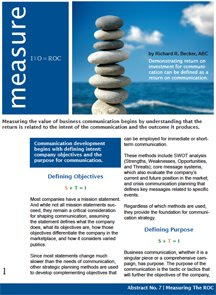
Almost two years, Harris Interactive, a full-service market research firm, presented a complimentary webinar that suggested mobile advertising was particularly adept at strengthening the bond between the brand and the consumer, communicating messages, and changing behavior.
It had good reason to. Although not part of the webinar, two days prior, Idol Gives Back had nearly broken records, raising more than $60 million for poor children in Africa and the United States. At $60 million, Idol Gives Back was just $1 million shy of the Jerry Lewis MDA Telethon.
In Louisville, Ky., that same program became a defining moment for the owners and employees of CW Multimedia. Several members of the team were watching American Idol when they recognized a new direction for their multimedia company. Mobile marketing was their future.
"We had already been kicking around the mobile marketing for several months," says Mike Willis, national sales director. "But the volume of text messages that came in that night really put a light under things."
The Kentucky Derby Provides The Test For Text
One year later, the Kentucky Derby Festival allowed festival fans to send text messages from their cell phones at selected events. The initial promotion, a simple Text-2-Win contest, asked fans to text “THUNDER” to a designated number to win VIP seats. More than 2,000 text messages were received in a couple hours.
CW Multimedia quickly modified the next event to include Text-2-Screen, allowing fans during concerts to text messages to a JumboTron screen at the venue. By October, Churchill Downs had teamed with Pepsi, allowing participants to purchase Pepsi products with instructions on how they could win six clubhouse tickets for the 2009 Kentucky Derby using their phones.
Toby Keith Presents Some Of The Possibilities
"One of our newest partners is country singer Toby Keith, whose fans can opt-in to his mobile fan club and receive updates, special offers, pre ticket sales, and all sorts of things," says Willis. "His fans also use Text-2-Screen at his concerts. You know, when we were growing up, we'd hold up lighters at concerts. Kids today are texting messages to the screen, adding themselves into the show."
Since adding the Mobile Fan Club, Keith has had more than 50,000 fans opt in to receive special offers, alerts, wallpapers, ring tones, and exclusive invitations. In addition, CW Multimedia tracks all activity, including text response via its own database software system. It tracks, in real time, information sent from the fan's phone, allowing some offers — such as a private meet and greet — to be sent to a specific area code or designated group within the database.
The benefit to fans? Imagine your favorite singer inviting you back stage after the show. Exactly.
The Future Of the Internet Is Predicted To Be Mobile
Last year, there were more than 250 million cell phone subscribers in the U.S., which represents about 82 percent of the population. By 2020, the Pew Internet & American Life Project projects that mobile devices will be “the primary connection tool to the Internet for most people in the world.”
"Mobile devices already represent more eyeballs than television sets or desktops," says Willis. "What a better way to connect to your audience or community no matter where they are, at any time … the first two things people look for before they head out the door are their wallets and phones."
CW Multimedia isn't the only one who thinks so. As the only company contracted with every carrier in the U.S., it has hosted mobile marketing promotions for Wal-Mart Stores Inc., Unilever, The Walt Disney Co., Universal Studios, TNA Entertainment LLC, and the NCAA. Even more remarkable, most of these promotions have been held in the last six months.
"We used to include several multimedia services, but the demand for mobile in the last six months has convinced us to specialize," says Willis. "Even our Web site services is focused on integrating other promotions or adding sites specifically for mobile phones. We're able to build in almost anything ... streaming video, live events, and database collection."
Highlights Of What Is Possible And On The Horizon
• Employee text message databases to help fill shifts and coordinate
• Pairing club cards with consumer databases to message customers on site
• Mobile coupons with text or bar codes that can be scanned from the phone
• GPS technology to identify and message select consumers based on proximity
• Send friends or customers for customized voice messages from celebrities
• Send friends or customers prepaid ringtones as gifts or for any other reason





















